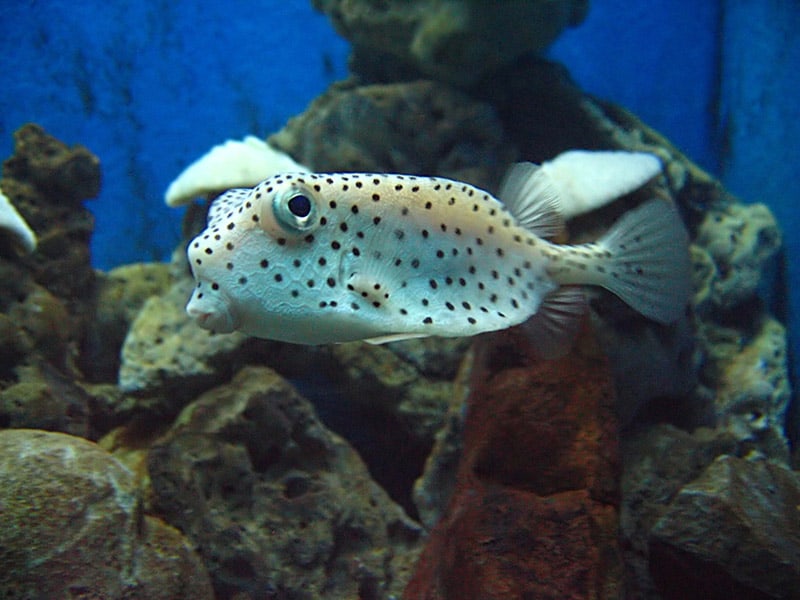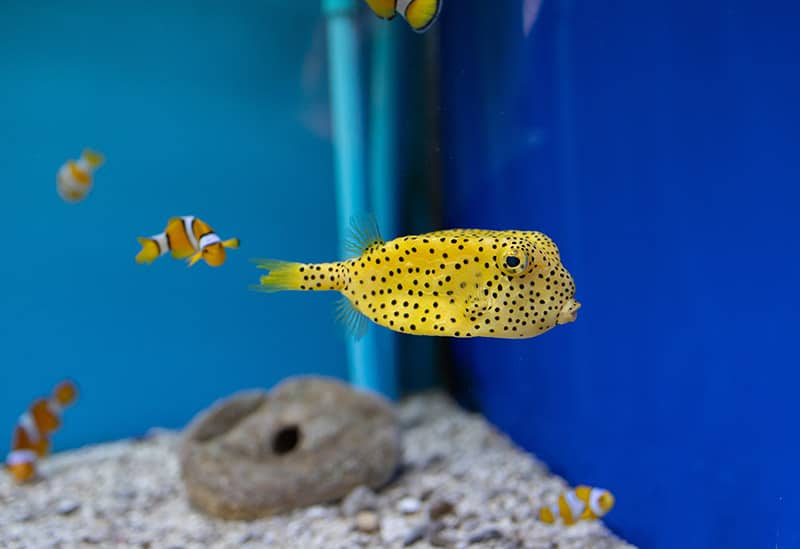The young Yellow Boxfish has an almost perfect box shaped body which becomes more elongated as it grows older. It also changes from the yellow or cream color when young to different colors when older, mostly yellow-green. The spots also change from dark-blue in the young fish to white with blue rings in the adult. The body is enclosed in a bony structure covered with a thin layer of skin with fins sticking out and no spiny dorsal fin.
Scientific Name
Ostracion cubicus
Boxfishes belong to the Tetraodontiformes order which also includes puffers, porcupinefish, and triggers. Boxfishes belong to the Ostraciidae family. Boxfishes are also commonly called cowfishes and trunkfishes (for example, the popular, Long Horned Cowfish – Lactoria cornutus).
Home Aquaria
Although many of the offerings in the fish stores are tiny, some as small as a dime, these fish can grow to 15-18 inches, therefore a large aquarium is recommended – 100 gallons and up. Boxfish like to hide, so hiding places should be offered and will provide a retreat from any perceived danger. The Yellow Boxfish requires no special lighting or temperature, very good tank conditions and water parameters are needed. Strong water movements cannot be handled by the young boxfish as they are slow swimmers. Make sure they can’t get sucked into any powerheads or filters you may have. They should be kept in Fish Only tanks as they will pick on (eat) soft corals, tube worms, etc. in reef tanks. The Yellow Boxfish should never share an overcrowded tank or have aggressive or fast moving tankmates. The Yellow Boxfish will swim all levels of the tank (top, middle, bottom).
According to Mark Taber’s Survey On Fishkeeping (from Albert Thiel’s website (http://www.athiel.com) and posts to rec.aquaria.marine.misc and rec.aquaria.marine.reefs newsgroups) which quoted Frank M. Greco’s list of fish unsuitable for captivity, the Yellow Boxfish should not be kept in the home aquaria. The fact that boxfish are so prone to ich was the reason for their being added to the list. Per Mr. Greco, “…a survey I did of local area wholesalers found that a minimum of 30% and a maximum of 100% of these fishes died. Necropsy found that most, if not all, of these animals were infested with Amyloodinium and Cryptocaryon. The degree of survival past the wholesaler/shopowner portion was small as well, if memory serves. And, these fishes tend to be copper sensitive to boot, IME (in my experience) with them. So utilizing copper on these fishes during quarantine seems to cause more problems than it’s worth. Many die from it and those that do not are never quite right afterwards. Malachite green is a good substitute, but it’s just not as effective as copper.”
While conversing with Mark and Frank to obtain their okays to quote, Frank requested that I also add the following to the article. “…you should also note that my designation of this fish as difficult is, at best, a subjective one. My reasonings behind listing this fish thusly are, IMO (in my opinion), sound ones. But, as in almost all cases, my experiences may not be the same as those of others. It is important that this be made known. My listings are not absolute, nor should they be taken that way.”
Thanks go to Mark Taber ([email protected]) and Frank M. Greco ([email protected]) for their permissions to quote.

Foods & Feeding
Before bringing your boxfish home, make sure it is eating at the store. You must be 100% sure your fish is eating. A boxfish that isn’t eating may already be stressed and any stressed fish won’t survive long, especially a boxfish with their ability to release toxins and susceptability to Cryptocaryon, etc. Larger and older fishes are harder to start feeding than younger ones.
Because they are naturally slow moving, shy, and rather clumsy, the Yellow Boxfish may very easily be outcompeted for food by tankmates, especially if the tankmates are aggressive fish. It is vital that you make sure your boxfish is eating regularly. If you keep your boxfish with more aggressive fish, it is best to feed them first, then concentrate on feeding your boxfish. That way, competition for food will be less.
The Yellow Boxfish is an omnivore and will eat all kinds of live, frozen, flake, and veggie foods.
Small fish (dime size) can be offered live and frozen brine shrimp as well as cubed frozen food like Ocean Nutrition’s Formula I and II (thawed or not, depending on how well it is taken). If they refuse the Formula I or II, you may try adding it at the same time as the brine shrimp and they may try it and you can slowly decrease the brine shrimp offered until they have switched. As they grow, they will develop a huge appetite and will even “beg” for food (swimming to you whenever you near the tank). Overall, a variety of foods is best, including seaweed (Ocean Nutrition’s Seaweed Selects or nori (dried seaweed used to wrap sushi – unseasoned). As in last month’s Kole Tang article, the seaweed can be offered in a suction cup clip or rubberbanded to a piece of rock or tank ornament.
Behavior
They are such slow movers that they are easily caught by hand. They move awkwardly using their side fins and the tail fin only in case of emergency or to get food. It is common for them to “sit” still in one spot for very long periods of time.
This fish can be extremely dangerous to other tankmates and itself. If threatened or stressed, they can release a toxin into the water which will kill everything in the tank, including themselves. Invertebrates are not safe from this toxin either. They may also release this toxin on death. If your boxfish looks diseased, stressed, or on the brink of death, it is vital that you remove it to a quarantine tank. A boxfish close to death will be lethargic and will experience rapid color fading in the minutes or hours before death. If one dies in the aquarium, remove it immediately, every second counts for the life of whatever else is in the tank. Hobbyists report all livestock in a 65 gallon tank dead in an hour and animals dying within seconds of a boxfish death.
Because of this ability to release a toxin, the yellow boxfish, and boxfish in general, are usually considered to be for the more experienced hobbyists as they are better suited in maintaining a stable environment, etc. Although it has been reported that they will rarely release this toxin, it is still a possibilty, and one best kept in mind when considering purchasing this fish.
If the tank has been hit with the toxin, hobbyists suggest the following to help combat it’s effects: remove fish to quarantine tank, perform 100% water change, make sure protein skimmer is running at top efficiency, add activated carbon to filtering system, when adding fish back do not put the water they are in back into the tank, another water change after system stabilizes (a week or so). Removal of the toxin from the tank is not entirely possible as it will settle into live rock, ornaments, bio bed, filters, etc. Using this method may prevent the death of your biological filter as the toxin is reduced and further dilution is possible through the subsequent water change(s), protein skimming, and addition of carbon.
Some reports note that this fish may or may not be aggressive towards it’s own kind, therefore, care should be taken when adding a new boxfish into a tank with an established boxfish. I cannot say for certain if this is true or not, but it was found in some of my research. Most hobbyists mention the Yellow Boxfish’s gentle nature (even so far as taking food from the hobbyists hand and being petted), but I couldn’t find anyone having kept more than one in a tank so I cannot say if this is true or not.
Disease Fighting
Boxfish develop skin diseases easily (Cryptocaryon, etc.) and are very difficult to treat. They cannot be treated with copper, which causes some controversy among hobbyists with some reporting success treating with copper, others report death, I prefer to go against using copper as my research shows more against than for. Why take the chance with an animals life? Do not give your boxfish a freshwater bath as is sometimes recommended as a treatment, as a matter of fact, avoid removing your boxfish from the tank as it will just stress them and a stressed boxfish may release it’s toxin. I would only recommend removing a boxfish, as I noted above, when already stressed, diseased, or on the brink of death.
Although they will survive nicely in normal water parameters, it is important to keep those parameters under control. No ammonia, nitrites, etc. If you let these parameters slip, you are asking for an outbreak of disease.
Boxfish will not tolerate cleaner wrasses well, but hobbyists report them allowing themselves to be cleaned by shrimp. They don’t like being cleaned by wrasses because they don’t have scales. Scaleless fish can be injured by cleaner wrasses who will harrass them long after there is anything left to clean and since boxfish swim so slow they can’t easily get away.

Cost
Store: From $15 to $40 with a 12 inch one going for $80. Two stores were checked in Queens, New York for prices.
Online: From $10 (small) to $14 (large). Two online sites were checked to obtain these prices.
This fish is only occassionally available through local fish stores, but is usually more available via online services.
Featured Image Credit: jirastudio, Shutterstock
